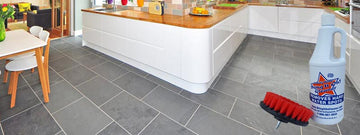Common Places where you can find dust
Your bathroom and kitchen are the most common areas that accumulate dirt really fast. It is especially true if you have children or pets at home. Water spots are also common in areas that are always wet, such as shower stalls or countertops.
Tile floors are incredibly durable. However, you cannot use just any cleaning solution as some may damage their enamel surface. You may opt for all-around solutions like Bring It On Cleaner that can handle both your kitchen and bathroom. However, your cleaning process still depends on the type of tiles that you have at home.
Worry not! Here is a quick guide on how to clean the most common types of tile floors in your house.
Types of Tile Floors and their Cleaning Guide
- Porcelain and ceramic tile floor
- Stone tiles
- Other types of tiles
Porcelain and Ceramic Tile Floors
Porcelain and ceramic tile floors are two of the most durable tiles around. They are also the easiest to clean. However, there are a few things that you can do to keep them looking good easily and for a much longer time. Here are some basic steps that you can follow:

- Remove loose debris first. Regularly vacuuming or sweeping your tile floors will prevent it from getting dull too soon. While these types of tiles are resilient to dirt, grit, and sand can damage the surface that may cause dullness if not cleaned every day.
- Use the right floor mop along with your favorite mild solution. A combination of mild detergent and clean water will do as well. Instead of using a sponge mop, use rags or chamois-type mops. Sponge materials tend to push dirty water deep into the grout lines, which makes them very hard to clean. Furthermore, make sure to replace your water with a clean one often, as dirty water will result in a cloudy floor.
- Watch out for specific tile stains. If you notice any discolorations, immediately determine the type of substance that caused the stain. Try to use your all-around cleaner, but if it does not work, you can always look for specific cleaning solutions that would target the stain. Just be sure to use the cleaning product gradually to avoid any damage.
- Be on the lookout for soap residue. If your floor is still hazy after cleaning, you may be dealing with soap residue. You can remove it with an all-purpose cleaner paired with a non-abrasive rag. You can also use a homemade cleaner by mixing a type of mild acid, such as lemon or line juice, with water.
- Do not let your ceramic or porcelain tiles air dry. Letting the water sit on the surface will form ugly water spots. Using a lint-free cloth right after cleaning will prevent any residue from forming.
Stone Tiles
Stone tiles like marble, granite, or slate can be a bit complicated to clean, as typical cleaning solutions can damage these types of surfaces. However, you can use cleaning solutions specifically made for such tiles. Here are a few things to keep in mind when cleaning specific tiles.

Marble
It is one of the most high-maintenance tiles around. Avoid cleaning solutions that are considered acidic. The lower the pH level is, the more acidic the solution is. You cannot use homemade vinegar or lemon cleaners as these components can etch the surface. Additionally, do not use abrasive tools such as bristles, brusher, or similar ones.

Slate
Much like marble, you cannot use acidic solutions as these can deteriorate the slate tile. Moreover, if the tile is coated, avoid air-drying the surface, as these can leave ugly spots. Use a soft towel to remove any excess liquid.

Granite
Much like many types of stone tiles, opt for a neutral cleaning solution, which can be found in mild cleaners. Harsh cleaning products may leave discoloration and streaks that are difficult to remove. Buffering a granite floor to keep it clean and shiny is also a good idea. This helps the tile resist dirt and dust.

Other Types of Tiles
Resilient tiles are popular these days as they are much cheaper and much more durable. These types of tiles are also quite easy to maintain. Here are a few things that you may want to remember in cleaning them:
Linoleum
These tiles look very similar to vinyl. However, it requires specific cleaning methods to keep it fresh and clean. First, remove dirt and other debris by vacuuming or sweeping. Use linoleum cleaners or a mixture of water and borax to clean the surface. Rinse with clean water, then let the floor dry. Enhance its durability by applying wax and buffing the surface every three to six months.
Vinyl Tiles
This type of tile is popular due to its resiliency. Vacuum or sweep the floor to remove dust or debris. Use a mop with an all-around cleaning solution to remove any discoloration or stains. Avoid using any scrubbing tool, as these can scratch the surface and leave your tile floor dull.
What is grout on the tile?
The real secret to a clean-looking tile is clean grout. The latter is porous, and it can easily absorb dirt and stain. After scrubbing your tiles and doing general cleaning, you can give the grout a little more attention. Make sure that you have rinsed the surface well. Then, apply enough of your all-purpose cleaner to cover the grout. Leave it for a few hours. If you are dealing with the worse built-up, you can leave the solution overnight. This will lift the deep-seated dirt on the grout. Rinse well. On the contrary, Follow the 5 easy steps to clean the tile grout.
You can do this every couple of months. Soaking it in cleaning products too often will erode the grout.

Best Methods for Protecting Your Ceramic Tiles
Follow these steps
- Use a squeegee
- Soft towel for water spills
- Protect with mats or rugs.
- Use ceramic tile cleaner to mop the floor.
Use a squeegee
After each use, wipe down the shower walls and tub using a squeegee. A towel is also a good option for wiping the moisture.
Soft towel for water spills
If you notice water spills, wipe up immediately using a soft towel. If the water dries, it can result in hard water marks.
Protect with mats or rugs
The areas like tubs and sinks where water splashing occurs can be protected using mats or rugs. Tracked-in water won’t dry on the floor if you place rugs at entryways.
Use ceramic tile cleaner to mop the floor
A good tile and grout cleaner should be used regularly for mopping up of ceramic tiles. Make sure the tile has been dried with a towel during this process.
All of these methods will increase the life of your ceramic tiles. If you seek a good cleaner to remove water stains from tile, get Bring It On Cleaner. It is convenient, safe, and highly effective. Order it today from here: bringitoncleaner.com.
Conclusion
Making sure that you are using the right products and methods to clean your tile floor is essential to making it last for many years to come. The tips above are just a few basic things that you have to keep in mind. Still, frequent cleaning is the key to keeping these tiles fresh and clean. Minerals like calcium and lime usually cause hard water stains on the tiles. These minerals lead to spots and streaks after the water gets dried. Due to regular mineral layer buildup, the spots get darkened. No doubt you can use a good tile and grout cleaner for this purpose, but there’s always a better to apply preventive measures.
Frequently Asked Questions
How can I restore the shine on my tile floors?
Regular cleaning and occasional professional polishing can restore shine to dulled tiles.
Can pets damage tile floors?
Pet nails can scratch tiles, and accidents can stain grout. Regular trimming and cleaning are recommended.
Is underfloor heating suitable for all tile types?
Most tiles can handle underfloor heating but always check with the manufacturer for specifics.





